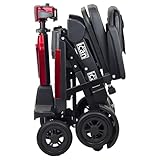Key Takeaways For Taking Your Mobility Scooter on Public Transport
Public Transport Regulations: This section explores rules for buses, trams, trains, and metros, highlighting designated areas, scooter security, and accessibility features.
Preparing for Transit: Advises on measuring scooter size, battery tips, and the advantages of collapsible scooters for public transport.
Tips for Seamless Travel: This section covers communication with staff, boarding/disembarking safely, securing scooters onboard, and preventing damage or theft for a smooth public transport experience.
Top Mobility Scooters
As society progresses towards inclusivity, modern transportation systems constantly evolve to accommodate all needs, including mobility scooter users. These changes symbolise societal progress and empower individuals to lead active, independent lives.
National and Local Public Transport Regulations
Rules Governing Buses and Trams
- Many buses and trams now have designated areas for mobility devices.
- Users may be required to secure their scooter during transit.
- Some vehicles offer ramps or lowered floors for easier access.
Train and Metro System Guidelines
- Trains often have specific carriages designed for wheelchair and mobility scooter accessibility.
- Advanced booking may be necessary for certain services to ensure space.
- Some stations are equipped with elevators and ramps to facilitate boarding.
Preparing Your Mobility Scooter for Transit
Ensuring Your Scooter Meets Size Requirements
- Measure your scooter’s dimensions; some transport systems have size limits for mobility devices.
- Collapsible scooters can be advantageous for public transport.
Charging and Battery Tips for Travel
- Ensure your scooter is fully charged before travel.
- Carry a portable charger or backup battery for longer trips.
Rights of Mobility Scooter Users on Public Transport
Accessibility Requirements and Laws
- Many countries have laws mandating accessible public transport for all, including those with mobility devices.
- Service providers might offer assistance services, but advance notice is often required.
Addressing Potential Discrimination or Issues
- Users have the right to report any discrimination they face during travel.
- Transport providers should have clear procedures for handling and resolving such complaints.
Tips for a Seamless Public Transport Experience
Communicating with Transport Staff
- Inform staff of your needs and ask about boarding procedures or if you need any assistance.
- Having a clear line of communication can lead to smoother transitions.
Boarding and Disembarking Safely
- Use ramps or lifts when available.
- Wait for other passengers to disembark before boarding to avoid congestion.
Storing and Securing Your Mobility Scooter Onboard
Utilising Designated Spaces
- Use designated areas for wheelchairs or strollers if available.
- Ensure your scooter doesn’t block aisles or exits.
Tips to Prevent Damage or Theft
- Use locks or alarms when leaving your scooter unattended.
- Place a name tag or identification on your scooter.
Alternatives and Back-Up Plans for Travelling with a Scooter
Considering Taxis or Ride-Shares
- Many services now offer accessible vehicle options. It’s recommended to book in advance.
Renting Scooters at Your Destination
- Some tourist destinations or cities offer scooter rentals, ensuring you don’t miss out on attractions.
Embracing Freedom and Accessibility in Your Travels
Incorporating mobility scooters into the vast public transportation landscape speaks volumes about societal growth. With knowledge, preparation, and the world gradually becoming more inclusive, mobility scooter users can embrace the joys and freedoms of travel like everyone else.
Top Mobility Scooters
Explore More Mobility Scooter Travel Guidelines
- Are Mobility Scooters Allowed on Trains? – Learn about the rules and regulations for taking your mobility scooter on public trains.
- Can Mobility Scooters Go on Buses? – Understand the guidelines for traveling with a mobility scooter on public buses.
- Choosing the Right Mobility Scooter – Find tips on selecting the perfect mobility scooter for travel and everyday use.
- Best Mobility Scooters for Travel – Explore compact and foldable mobility scooters that are ideal for travel and public transport.












